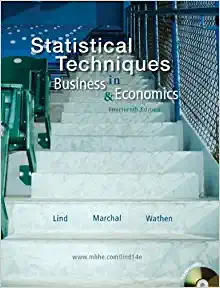Question
In economics, elasticity refers to the responsiveness of one variable to changes in income only the same variable another variable price only If the percentage
- In economics, elasticity refers to the responsiveness of one variable to changes in
- income only
- the same variable
- another variable
- price only
- If the percentage change in quantity demanded divided by the percentage change in price is less than one, we must have
- elastic supply
- inelastic demand
- inelastic supply
- elastic demand
3. A precisely 15-percent change in quantity demanded results from a precisely 15-percent change in price. In this case, the price elasticity of demand is _____.
- inelastic
- elastic
- unitary
- unknown in terms of elasticity
4. Say quantity supplied increases 20 percent after a 5 percent increase in price. In this case, we know that _____.
- demand is elastic
- supply is elastic
- supply is inelastic
- demand is inelastic
5. The midpoint formula for calculating elasticity uses the same base, average quantity and average price, meaning the end result will be
- larger for a price decrease.
- different depending on whether there is a price increase or decrease.
- larger for a price increase.
- the same regardless of whether there is a price increase or decrease.
6. Which of the following elasticities could be the result of the midpoint method on an inelastic part of the demand curve?
- 1.95
- 1.00
- 4.45
- 0.45
7. A 7.9% change in price results in a 26.5% change in quantity supplied. As a result, the price elasticity of supply is _____.
- 3.35
- 7.9
- 26.5
- 0.29
8. Infinite (or perfect) elasticity of demand could be demonstrated graphically with a
- horizontal demand curve.
- upward sloping straight line representing demand.
- downward sloping curved arc representing demand.
- vertical demand curve.
9. Because substitutes in consumption can take a long time to find,
- elasticity of demand is often lower in the short run.
- elasticity of demand is often higher in the short run.
- elasticity of supply is often higher in the short run.
- elasticity of demand always equals elasticity of supply in the short run.
10. The cross price elasticity of demand for related goods A and B is calculated to be -3.0. Without needing any more information, we know that goods A and B are _____.
- substitutes
- normal
- complements
- inferior
11. Intermediate goods, which go into producing other goods, are
- included in GDP calculations to balance out illegal goods.
- excluded from GDP calculations to avoid double counting.
- included in GDP calculations to ensure correct totaling.
- never a part of the production process.
12. The demand measure of GDP accounting adds together
- consumption, investment, government spending on goods and services, and spending on imports only
- consumption, investment, government spending on goods and services, and spending on net exports
- consumption, investment, government spending on goods and services, and interest
- consumption, profit, government spending on goods and services, and spending on net exports
13. Which of the following is not counted as a part of GDP?
- the unsold additions to inventory at a pet food shop
- the purchase of 200 shares of Nike stock by an investor
- the purchase of a street sweeper vehicle by the city of San Francisco
- the purchase of a load of mulch by a consumer
14. Based on our textbook Table 6.5 Links to an external site., the nominal GDP in the United States in 2000 was about _____.
- 13,095 billion dollars
- 4,347 billion dollars
- 10,290 billion dollars
- 14,958 billion dollars
15. To compare the GDP of two different countries with different currencies, it is necessary to use
- per capita GDP
- bitcoin
- the barter system
- an exchange rate
16. Gross Domestic Product equals $980 billion. If consumption equals $610 billion, investment equals $120 billion, and government spending equals $260 billion, then
- exports exceed imports by $100 billion
- imports exceed exports by $100 billion
- exports exceed imports by $10 billion
- imports exceed exports by $10 billion
17. Peru has a GDP of 733,000 billion Peruvian soles, and a population of 33 million. The exchange rate is 3.6 Peruvian soles per U.S. dollar. The GDP per capita of Peru as measured in U.S. dollars is approximately.
- $6,535.71
- $22,212.12
- $6,170.03
- $203,333.33
18. Investment (I) tends to
- include only government expenditure (G).
- be precisely equal to the trade balance (X - M).
- stay relatively constant over time, compared to consumption (C), which is volatile.
- fluctuate more noticeably than consumption (c)
19. Ethiopia has a GDP of $9 billion (measured in U.S. dollars) and a population of 51 million. Costa Rica has a GDP of $10 billion (measured in U.S. dollars) and a population of 5 million. Calculate per capita GDP for each country.
- Ethiopia = $1,764.71; Costa Rica = $200,000.00
- Ethiopia = $176.47; Costa Rica = $2,000.00
- Ethiopia = $17.65; Costa Rica = $2,000.00
- Ethiopia = $17.65; Costa Rica = $200.00
20. The real value of any economic statistic refers to the statistic after it has been adjusted for inflation, while the _____ refers to the number that is actually announced at that time.
- infinite value
- nominal value
- adjusted value
- net value
Step by Step Solution
There are 3 Steps involved in it
Step: 1

Get Instant Access to Expert-Tailored Solutions
See step-by-step solutions with expert insights and AI powered tools for academic success
Step: 2

Step: 3

Ace Your Homework with AI
Get the answers you need in no time with our AI-driven, step-by-step assistance
Get Started


